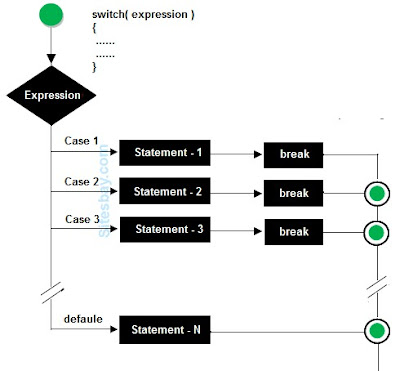Switch statement in c++ | C++ switch statement | nested switch statement in c++ | nested of switch statement | c++ example of switch statement | My CS Tutorial
Its objective is to check several possible constant values for an
expression.
switch statement
A switch statement allows a variable to be tested for equality against a list of values. Each value is called a case, and the variable being switched on is checked for each switch case.
Syntax
The syntax for a switch statement in C programming language is as follows:
switch(expression){
case constant-expression :
statement(s);
break; /* optional */
case constant-expression :
statement(s);
break; /* optional */
/* you can have any number of case statements */
default : /* Optional */
statement(s);
}
Flow Diagram
 |
| Flow diagram of switch statement |
The following rules apply to a switch statement:
(i) The expression used in a switch statement must have an integral or enumerated type, or be of a class type in which the class has a single conversion function to an integral or enumerated type.
(ii) You can have any number of case statements within a switch. Each case is followed by the value to be compared to and a colon.
(iii) The constant-expression for a case must be the same data type as the variable in the switch, and it must be a constant or a literal.
(iv) When the variable being switched on is equal to a case, the statements following that case will execute until a break statement is reached.
(v) When a break statement is reached, the switch terminates, and the flow of control jumps to the next line following the switch statement.Not every case needs to contain a break. If no break appears, the flow of control will fall through to subsequent cases until a break is reached.
(vi) A switch statement can have an optional default case, which must appear at the end of the switch. The default case can be used for performing a task when none of the cases is true. No break is needed in the default case.
Example
#include <iostream.h>
int main ()
{
/* local variable definition */
char grade = 'B';
switch(grade)
{
case 'A' :
cout<<"Excellent!\n" ;
break;
case 'B' :
case 'C' :
cout<<"Well done\n" ;
break;
case 'D' :
cout<<"You passed\n" ;
break;
case 'E' :
cout<<"Better try again\n" ;
break;
default :
cout<<"Invalid grade\n" ;
}
cout<<"Your grade is %c\n"<<grade ;
return 0;
}
When the above code is compiled and executed, it produces the following result:
Well done
Your grade is B
Nested switch Statements
It is possible to have a switch as a part of the statement sequence of an outer switch. Even if the case constants of the inner and outer switch contain common values, no conflicts will arise.
Syntax
The syntax for a nested switch statement is as follows:
switch(ch1) {
case 'A':
printf("This A is part of outer switch" );
switch(ch2) {
case 'A':
printf("This A is part of inner switch" );
break;
case 'B': /* case code */
}
break;
case 'B': /* case code */
}
Example
#include <iostream.h>
int main ()
{
/* local variable definition */
int a = 100;
int b = 200;
switch(a) {
case 100:
cout<<"This is part of outer switch\n"<<a;
switch(b) {
case 200:
cout<<"This is part of inner switch\n"<<a;
}
}
cout<<"Exact value of a is : %d\n"<<a;
cout<<"Exact value of b is : %d\n"<<b;
return 0;
}
When the above code is compiled and executed, it produces the following result:
This is part of outer switch
This is part of inner switch
Exact value of a is : 100
Exact value of b is : 200
Switch statement in c++ | C++ switch statement | nested switch statement in c++ | nested of switch statement | c++ example of switch statement | My CS Tutorial
_______________________________________
Please share this post and blog link with your friends.For more programs use this blog.
If you have any problem, please comment in comment box, subscribe this blog for notifications of new post on your email and follow this blog.If you have any method of this tutorial or program or want to give any suggestion send email on hc78326@gmail.com
Created by-- HARSH CHAUHAN















No comments:
Post a Comment